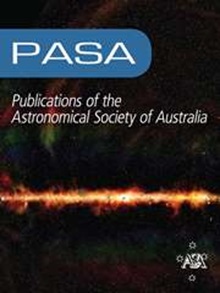DARK SAGE:具有多维结构和最小自由参数的新一代半分析星系演化
IF 4.6
3区 物理与天体物理
Q1 ASTRONOMY & ASTROPHYSICS
Publications of the Astronomical Society of Australia
Pub Date : 2024-02-27
DOI:10.1017/pasa.2024.14
引用次数: 0
摘要
经过五年多的发展,我们推出了新版本的 "黑暗贤者"(Dark Sage),这是一个星系形成的半解析模型(SAM),打破了同类模型的模式。该模型的主要变化之一是对恒星反馈进行了全面的处理。恒星反馈源于能量守恒,在局部尺度上运行,随着时间的推移而逐渐影响气体,而不是瞬间影响气体,并预测每个星系的质量负荷因子。在该模型所解析的星系角动量结构的基础上,我们现在考虑了恒星盘的加热问题,并对恒星盘的径向和纵向结构进行了预测。我们通过跟踪每个环中恒星年龄的分布,为恒星盘增加了一个新的维度。在模型中,每个环面年龄分区都有自己的速度弥散和金属性演化。这使得 "黑暗贤者 "能够对星系的结构进行预测,而以前只有流体力学模拟才能做到这一点。我们展示的是在 MillenniumTNG 软件包中最高分辨率的纯重力模拟的合并树上运行的模型。尽管黑暗贤者模型相对于其他模拟系统具有额外的复杂性,但它只有三个自由参数,是所有模拟系统中最少的,我们使用粒子群优化方法完全根据宇宙恒星形成历史以及z=0恒星和Hi质量函数来校准这些参数。黑暗贤者的代码库是用 C 和 python 编写的,可在 https://github.com/arhstevens/DarkSage 上公开获取。本文章由计算机程序翻译,如有差异,请以英文原文为准。
DARK SAGE: Next-generation semi-analytic galaxy evolution with multidimensional structure and minimal free parameters
After more than five years of development, we present a new version of Dark Sage, a semi-analytic model (SAM) of galaxy formation that breaks the mould for models of its kind. Included among the major changes is an overhauled treatment of stellar feedback that is derived from energy conservation, operates on local scales, affects gas gradually over time rather than instantaneously, and predicts a mass-loading factor for every galaxy. Building on the model’s resolved angularmomentum structure of galaxies, we now consider the heating of stellar discs, delivering predictions for disc structure both radially and vertically. We add a further dimension to stellar discs by tracking the distribution of stellar ages in each annulus. Each annulus–age bin has its own velocity dispersion and metallicity evolved in the model. This allows Dark Sage to make structural predictions for galaxies that previously only hydrodynamic simulations could. We present the model as run on the merger trees of the highest-resolution gravity-only simulation of the MillenniumTNG suite. Despite its additional complexity relative to other SAMs, Dark Sage only has three free parameters, the least of any SAM, which we calibrate exclusively against the cosmic star formation history and the z =0 stellar and Hi mass functions using a particle-swarm optimisation method. The Dark Sage codebase, written in C and python, is publicly available at https://github.com/arhstevens/DarkSage .
求助全文
通过发布文献求助,成功后即可免费获取论文全文。
去求助
来源期刊
CiteScore
5.90
自引率
9.50%
发文量
41
审稿时长
>12 weeks
期刊介绍:
Publications of the Astronomical Society of Australia (PASA) publishes new and significant research in astronomy and astrophysics. PASA covers a wide range of topics within astronomy, including multi-wavelength observations, theoretical modelling, computational astronomy and visualisation. PASA also maintains its heritage of publishing results on southern hemisphere astronomy and on astronomy with Australian facilities.
PASA publishes research papers, review papers and special series on topical issues, making use of expert international reviewers and an experienced Editorial Board. As an electronic-only journal, PASA publishes paper by paper, ensuring a rapid publication rate. There are no page charges. PASA''s Editorial Board approve a certain number of papers per year to be published Open Access without a publication fee.

 求助内容:
求助内容: 应助结果提醒方式:
应助结果提醒方式:


